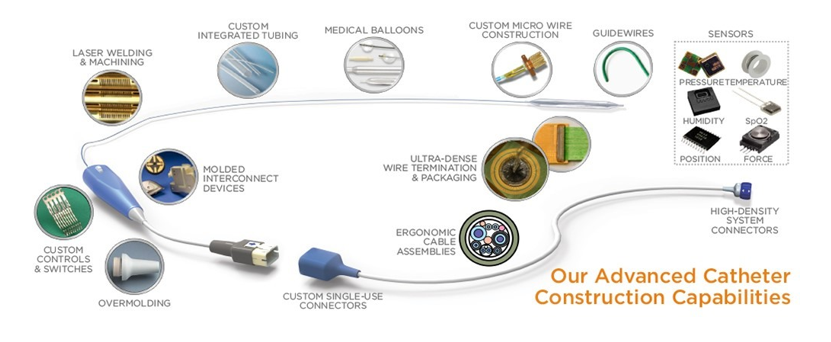Implantable Sensor
SENSORS IN CATHETERS AND BODY CAVITIES
The requirements for sensors that can be inserted through an incision – typically at the tip of a catheter – are less critical than those for implantables but will still need FDA approval. Depending on the surgical procedure, these sensors need to function for a few minutes up to a couple of hours and can be powered via external sources. A pair of matched thermistors at the tip of a catheter can be guided to different locations of the heart to measure blood flow. Either they can be heated through the coil or flushed with cold fluid to measure blood flow rates. When flushed with cold fluid, the first sensor gets cooled more than the second because the blood flow warms up the fluid that reaches the second sensor. Since these two temperature sensors are separated by a known distance where the temperature and volume of the fluid is controlled, the blood flow can be calculated by reading the difference of the resistance values of the two sensors. These thermistors do not require external power.
Catheter Ablation Sensors
These sensors are temporarily inserted through incision. The catheter tip contains a source for RF energy and a force load cell sensor. RF energy, like that used with implantable sensors to send data, is often used in the ablation process to burn out dead tissue. It is critical that the force applied by the catheter tip to the target tissue not exceed maximum values to avoid any possibility of perforating the target tissue. TE’s sensing technology holds the promise of providing a triaxial force-sensing system able to measure tissue contact forces in all three dimensions simultaneously.

Silicon MEMS-based Disposable Pressure Sensors
These are used in intrauterine pressure (IUP) sensors to measure contraction pressure and frequency during childbirth. This method is more reliable than conventional belts and is used in critical cases. Additional features can be built into these sensors such as amnion fluid infusion and extraction. These sensors are inserted through the uterus and reside in the amniotic sac. The sensor is the taken out when the baby is ready to be delivered.
Body Cavity Sensors
These sensors include oral and rectal probes that measure body temperatures. These temperature sensors are designed to be small and rugged, and are covered with a soft coating material to protect the inner layer of the organs of the patient from sustaining damage due to contact.
Micro-Thermocouple Sensors
These sensors are flexible fine gage thermocouples used whenever fast, accurate temperature measurements are required. The thermocouple consists of two dissimilar metals, joined together at one end. A small unique voltage is produced by the two metals, which can be measured and interpreted by a thermocouple thermometer. The dissimilar metals are individually insulated, and an overcoat is present to maintain an intimate bifilar configuration (certified per ANSI MC96.1-1982). TE’s Micro-Thermocouples are constructed using only bio-compatible materials, making them suitable for use in medical applications.
EXTERNAL SENSORS EXPOSED TO FLUIDS
There are several disposable sensors where the sensor is located externally from the body although body fluids come in contact with it. One example of this is the disposable blood pressure sensor (DPS). These sensors are used in surgical procedures and intensive care units (ICUs ) to continuously monitor the blood pressure of the patient. This is the reliable way to measure blood pressure when in surgery or ICU. The informational profile of the patient is then logged by plugging the disposable blood pressure sensor into a monitor. These sensors are required to be replaced every 24 hours in order to avoid contamination. Another sensor that comes in to contact with medication and body fluids is the sensor used in the inflation of angioplasty balloons. A pressure sensor at the tip of the pump will come in to contact with saline solution that is used as a media to inflate and deflate the balloon. In this application, the pressure sensor monitors the pressure applied that inflates/deflates the balloon and needs to withstand more than 200psi. If too much pressure is applied, the balloon could burst and cause severe complications for the patient.
Article Source: https://spectrum.ieee.org/biomedical/devices/choosing-sensors-for-medical-applications
